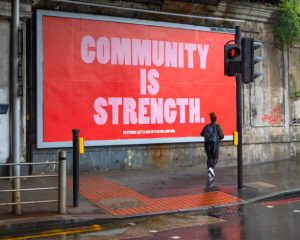Introduction
“…but explanations alone do not bring us to the practice of beloved community…” – bell hooks
Where does the energy come from that all living organisms need to grow and develop? This seems a strange question to ask when this book is all about community psychology and not life science right? Yet we are hoping that the question makes more sense when we recognize that a community is a living organism and needs certain nutrients as all organisms do to convert to energy that of course, is used to develop and grow! It

should be noted that a community isn’t just geographic space, although it certainly can be. Like the concept of “home” it can be emotional as well, or both geographic and emotional. There are virtual communities, communities of people who similarly identify based on a number of facets and find a safe space to express group affiliation—-a community of professors, community practitioners, and so forth. A second relevant question might be, just what are the nutrients that a community needs to grow and develop? This book offers some answers to this question.
Thinking through this, a healthy community needs its citizens to be invested. It also needs kinship partners to invest in the community in concert with other citizens. In a physical community needs range from local small businesses, quality physical and mental health entities, grocery stores, parks and recreational facilities, schools and faith-based institutions, banks and social services, among so many other resources. What happens to a physical community when its needed resources are scarce or not available? Just like any living organism that does not receive proper nutrients, it does not remain healthy. How do we enjoin with another community, as a community? This book offers one of the answers to this question as well.
The field of community psychology has international origins that vary across continents. In the United States a number of antecedents including the development of preventive perspectives in mental health, reforms in the mental health systems, group dynamics and action research, and movements for social change and liberation are evidenced (Kloos et al., 2012).

Born out of the optimism of society that surfaced after these social change movements of the 1960s took place, and the allied victory of World War II, a group of clinical psychologists were ready for a movement of their own. At a conference for psychologists in 1965, at Swampscott, Massachusetts, a group of clinical psychologists’ voices were lifted and heard. The work which they were doing in communities and the implications of deinstitutionalization demanded a new discipline. One that spoke to social change in society and professionals becoming change agents starting within communities. Community psychology was born with the onset of community mental health training programs as well as one of the first clinical-community doctoral programs which began at DePaul University in Chicago in 1966. Another program began in 1966 at the University of Texas at Austin by Ira Iscoe. By 1975, 141 graduate programs existed to formally train community psychologists (Jason et al., 2019, p. ). Further community-based research and action took off and in the same year another important component was established, Division 27 of the American Psychological Association (APA) which is now the Society for Community Research and Action. Simultaneously, in response to systems of repression and political exclusion, forms of community psychology were being established in Canada, Australia, New Zealand, Germany, Puerto Rico, Venezuela, Mexico, and Cuba. In Italy, community psychology grew out of efforts to close psychiatric hospitals, and an overarching effort to shift educational, social, and health systems towards an emphasis on prevention, citizen participation and the reduction of victim-blaming (Santinello et al., 2010) and further growth of the field was seen in South Africa in the 1980s as psychologists engaged in the fight against the apartheid regime (Yen, 2007).
Before we dig deeper into this collection of community psychology case stories, let’s take a step back and look at the field of community psychology itself and how the role of a community psychology practitioner is different from other social service-based roles. By “social service” based roles we mean roles where the focus is on the health, wellness, and actualization of individuals, families, and communities.
There are many occupations in the social service sector: medical health professionals (e.g., doctors, nurses, medical technicians and supporting medical staff), educational professionals (e.g., teachers, scholar-activists, and child care workers), community infrastructure professionals (e.g. community center managers, policing, community developers and organizers, alderpersons, and community program coordinators) and identity health professionals (e.g., social workers, psychologists, school counselors, therapists). These lists are not exhaustive and there are many opportunities and situations where there is overlap and collaboration between all roles. That said, there is one role that includes all of these types of tasks and that is the role of the community psychologist.
Psychologists of all types are focused on identity construction and how an individual or group develops an identity and uses that identity as a framework for accomplishing goals, life tasks, and achieving their best lives. Many times psychologists work with individuals and groups they are trying to help to develop interventions, ways the system can be shifted and transformed in order for the individual or group to have the best opportunity to live their preferred lives with a sense of agency that demonstrates their understanding of the best version of their ideas about themselves or rather their identity.
For example, a clinical or family and practice psychologist uses talk therapy as well as other techniques like hypnosis or cognitive-based therapies (CBT) to help an individual better see how their understanding of themselves are constructed through their lived experiences within their environments and their family of origin. The psychologist might then help them diminish, dampen and overcome some aspects of those constructions about themselves as they bring forward and strengthen preferred aspects of the person they want to become and are becoming.
A social psychologist studies social norms and conventions and the influence and impact they have on the thinking and behavior of individuals. A social psychologist might devise studies that look at the correlations and consequences or stereotypes, prejudice or discrimination on individuals. Or they might look at how groups make certain types of decisions. The goal is to identify variables that might be leveraged to develop interventions that shift the social system toward more positive outcomes.
An organizational psychologist might look at similar phenomena as a social psychologist but within the context of the workplace. Organizational psychologists may devise studies that look at employee satisfaction and human performance in the workplace and devise interventions that optimize those outcomes.
Now, what about a community psychologist? The central focus of a community psychologist is on identifying, studying, and better understanding the dynamics and patterns of a community that impact individuals, families and our broader society. In addition, through this work community psychologists also seek to better understand a community’s impact on individuals, families and our broader society. Community psychologists use social science research methods to understand these dynamics and patterns of influence. With this lens and framework a community psychologist seeks to also eradicate structural systems of oppression and inequity that negatively impacts individuals, families, and communities and seeks ways to eradicate these systems.
A community psychologist might conduct studies, specifically through participatory action research (PAR), phenomenological, ethnographic studies, or photovoice. The results of their studies can be used to inform interventions and promotion strategies that might take the form of a type of Community Action Program (CAP). This work can involve community psychologists applying for grants to conduct research and open the door for community agencies to apply for grants using the studies as data to inform action plans. This work might include a follow-up study that demonstrates that the proposed intervention or prevention strategy worked. In this respect, community psychologists are not just scientists, they are community activists, organizers, abolitionists, and change leaders.
A community psychologist’s work has a specific applied focus such as conducting studies and developing interventions and prevention strategies alongside of individuals and families who comprise a community, they imagine new possibilities together to meet community challenges and co-create and promote environments where equitable resources can be realized sustainably. While community psychologists often work in academic settings, others work in research institutions or governmental organizations, or as community practitioners in a number of roles including community developers or organizers, program evaluators, or within human services and nonprofit organizations. Community psychologists are often teachers or professors in academia and community practitioners! To learn more about the depth and breadth of this exciting and important field see Jason, Glantsman, O’Brien & Ramian Eds. (2019) Introduction to Community Psychology: Becoming an Agent of Change. This book is focused on the community psychologist as practitioner and is written to provide a glimpse into how practitioners carry out their work in diverse and complex communities and for pure motivation for all of us to get out and change the world!
The structure of Case Studies in Community Psychology: A Global Perspective is organized into four sections: Community Building, Global Perspectives, Evaluation Research, and Community and Public Health. Community Building houses three case stories from Dr. Jacqueline Samuel who authored Cultural Development in Underrepresented Communities: Using an Empowerment and Citizen Participation Framework giving the reader a well-spring of information on the positive linkage between the arts and community development. Next is Dare2Dialogue, where Dr. Amber Kelly and Kathleen McAuliff share important points on inclusivity among the disability community. Dr. Hoffman’s Green Space Programs as a Shared Growth and Communal Process: A Somali Gardener’s Journey in Minnesota combines the intersection of gardening and community building.

In section three, Program Evaluations and Research the textbook provides case stories that depict what it looks like for community psychologists to work as consultants in program evaluations. Drs. Susan Wolfe and Kyrah Brown, et al. gives first-hand experiences including lessons learned in Lessons from Conducting an Equity-Focused, Participatory Needs Assessment. Dr. Patricia O’Connor’s case story Program Evaluation: A Fundamental Component in Effective Community Practice is next in this section. The case story focus is on the importance of program evaluations in community psychology practice. A third case story in this section is Dr. Anna Pruitt et al., Showing up and Standing With: An Intersectional Approach to a Participatory Evaluation of a Housing First Program on Oahu. Pruitt et al., describes a five-year, ongoing participatory evaluation program between a housing program and stakeholders. The last section Community and Public Health is comprised of three case stories: A Plan for Prevention: Measuring Equity from the Start by Dr. Tonya Roberson who discusses the importance of using a collective-impact approach and culturally tailored data collection tools to advance health parity. Following Dr. Roberson’s work is Dr. Dessie Clark’s and Joshua Brown’s work, Working with Survivors of Gender-Based Violence. The case story does a great job in highlighting how communities can be a tremendous source of support for gender-based violence. Our third case story in this section is Dr. Deidra Somerville’s case story Journeying Past Hurt: Creating and Sustaining Trauma-Informed Healing Practices With Lower SES Black Pregnant and Parenting Mothers showing the process of development of a curriculum to address trauma among Black children and families. Along with these 11 great case stories, this textbook has some wonderful features that you will learn from and enjoy! The case studies are meant to be a starting point in your journey of learning how to identify and study the different variables that drive the system of communities and how seasoned and new practitioners go about using their research, backstories, practice, and praxis in a practical way to engage all the parts of a community to achieve positive change. We use active links to web pages, articles, podcasts, videos, and more to provide an interactive experience that is sure to be a great learning journey! Go ahead, you’re a click away!
References
Jason, L.A., Glantsman, O., O’Brien, J.F., & Ramian, K. N. (2019) Introduction to community psychology: Becoming an agent of change. Rebus Pressbooks https://press.rebus.community/introductiontocommunitypsychology/
Julian, D.A. (2006). A community practice model for community psychologists and some examples of the application of community practice skills from the partnerships for success initiative in Ohio. The American Journal of Community Psychology Practice, 37(1-2), 77-93.
Kloos, B., Hill, J., Thomas, E., Wandersman, A., Elias, M.J., & Dalton, J.H. (2012). Community psychology. Wadsworth, Cengage Learning.
Mustoe, L.R., & Croft, A.C. (1999). Motivating engineering students by using modern case studies. International Journal of Engineering Education 15(6), 469-476.
Santinello M., Martini E.R., & Perkins, D. (2010). Community psychology in Italy: Introduction and prospects. Journal of Prevention and Intervention in the Community, 38, 1-7, DOI: 10.1080/10852350903393376
Tsui, L. (2002). Fostering critical thinking through effective pedagogy: Evidence from four institutional case studies. The Journal of Higher Education 73(6), 740-763.
Yen, J. (2008). Chapter 14: A history of community psychology in South Africa in Interior: A history of psychology in South Africa, in Omen C.V. & Painter, D. Eds. Compleat Unissa Press.


Feedback/Errata